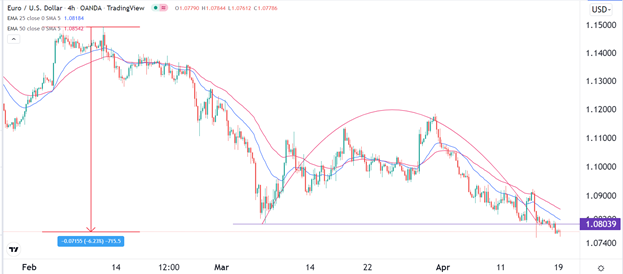Bearish View
- Sell the EUR/USD pair and set a take-profit at 1.0720.
- Add a stop-loss at 1.0850.
- Timeline: 1 day.
Bullish View
- Set a buy-stop at 1.0840 and a take-profit at 1.0900.
- Add a stop-loss at 1.07200.
The EUR/USD price remained in a tight range on Monday and Tuesday morning as the market reflected on the rising bond yields. The pair also wavered after signs showed that the Chinese economy was slowing down. It is trading at 1.0778, which was also the lowest level on March 7th.
Rising US Bond Yields
The EUR/USD pair remained under pressure as investors focused on activities in the bond market. The bond sell-off continued as investors priced in more tightening by the Federal Reserve. As a result, the yield of the 10-year rose to 2.83% while the 30-year and 2-year rose to 2.93% and 2.46%, respectively.
These were the highest they have been in a few years. The performance of the bond market is mostly because of the ongoing thinking that the Federal Reserve will be more aggressive in the coming month. Investors expect that the Fed will hike interest rates by 0.50% in its meeting in May.
The EUR/USD has therefore declined because of the divergence between the Fed and the European Central Bank (ECB). In its meeting last week, the ECB signaled that it will continue winding down its asset purchases. It will then start hiking interest rates in the third or fourth quarter.
The euro is also falling as the uncertainty of the European economy remains. With the crisis in Ukraine continuing, there are expectations that the economy will retreat. For one, the EU has made plans to end importing oil from Russia and there are hopes that it will stop importing natural gas.
The economic calendar will be a bit muted today. The key economic data to watch will be the latest US housing starts and building permits numbers. Economists expect that the number of building permits declined from 1.865 million to 1.825 million. They also see the housing starts falling from 1.79 million to 1.745 million.
EUR/USD Forecast
The EUR/USD pair has been in a strong sell-off in the past few months. It has dropped by about 6% from its highest level in February. The pair has moved slightly below the 15-period and 25-period moving averages, which is a signal that bears are in control. The pair is also trading at the same level as its lowest point on March 7th.
Therefore, there is a likelihood that the pair will continue falling as bears target the next key support at 1.0700. A move above the resistance at 1.085 will signal that there are mor buyers in the market.


